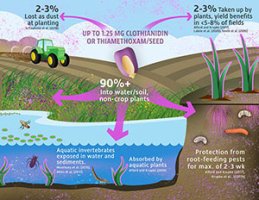New bee-friendly restrictions on neonicotinoid insecticides in New York … and a barrier to further progress on this topic in the USA
In the two previous
As everyone knows, fixing a problem before it starts is better than fixing a problem that’s existed for several years. For example, improving the risk assessment process so bee-harming pesticides aren’t sold is better than realizing after several years that environmental harm has been done, then creating reactionary laws to ban the pesticide. But either way of fixing a problem is better than ignoring it.
So, until the pesticide risk assessment process is improved, unfortunately we have to rely on reactionary laws that ban harmful pesticides. For the seventy-third Notes from the Lab, I’m going to highlight one of these reactionary laws. Specifically, I’m going to highlight recent nation-leading legislation in New York that will restrict certain uses of neonicotinoid insecticides due to the overwhelming scientific evidence, accumulated over more than two decades, that shows frequent risk to bees and infrequent economic benefits for farmers. This legislation is an attempt to fix a problem that’s existed for half of my lifetime.
But I’m also going to temper this new evidence-based policy with a warning. I’m going to highlight two examples from the 3.5-year deliberation over this new law that reveal a major barrier to evidence-based pesticide policies in the USA: disinformation from a small number of scientists whose goal is to obscure scientific evidence, thereby delaying or preventing regulation.
Let’s get into it. First, for anyone who’s tired of reading about neonicotinoid insecticides (neonics), let’s acknowledge that neonics aren’t the only stress that’s causing problems for bee species. In fact, they’re not the only pesticide class that’s causing problems for bees. Last month’s article was especially useful at showing how exposure to indoxacarb (an oxadiazine insecticide) and six other non-neonicotinoid insecticides reduced reproduction of bumble bee colonies across 106 farms in Europe. But that doesn’t mean exposure to neonics isn’t a major stress on bees. As described below, there’s extensive evidence that neonics are indeed having a negative impact on bees in the USA.
Second, for anyone who doesn’t already know, the European Food Safety Authority (EFSA) banned neonics from use on pollinator-attractive outdoor crops in 2013, then fully banned them from all outdoor agricultural uses in 2018, due to unacceptable risk to managed honey bees and wildlife. Neonicotinoid insecticides are currently the most-used insecticides in the USA and have never been banned from use on any crop in the USA despite the same scientific evidence considered by the EFSA and the EPA (the EPA is the USA’s equivalent of Europe’s EFSA). In other words, the reason neonics are currently banned in Europe but not banned in the USA has nothing to do with the underlying scientific evidence. Instead, it has to do with sociopolitical differences in how scientific evidence is considered by the public, regulatory agencies, and policymakers.
With this context, I was intrigued to be contacted in 2018 by a representative from the New York state governor’s office inquiring if the Dyce Lab would be willing to develop a risk-benefit analysis for neonics in collaboration with an economist. The goal would be to synthesize all existing scientific evidence on economic benefits of neonics to farmers and risk to pollinators in the five major application contexts in which they’re used: field crops (corn, soybean, wheat), fruit crops (e.g., apple, strawberry, blueberry), vegetable crops (e.g., squash, pumpkin), ornamentals, turf and landscape management (e.g., golf courses, ornamental plant nurseries), and forestry (e.g., control of hemlock woolly adelgid in forests).
Over the course of two years, we compiled a mountain of data on neonics, eventually publishing our 432-page report in June 2020 (Grout et al., 2020) and making it publicly available on the Dyce Lab website. You can read the full report at the following link: https://cornell.app.box.com/v/2020-neonicotinoid-report. And for those of you who don’t want to wade through 432 pages (I totally understand!), we also wrote a 4-page summary and published it in ABJ in September 2020. You can read the 4-page summary at the following link: https://blogs.cornell.edu/mcartlab/files/2020/09/09-McArt-article_September2020.pdf
What were the major take-home messages of the risk-benefit report on neonics? Bees foraging in and near corn and soybean fields planted with neonicotinoid-treated seeds are likely to experience harm that will negatively impact their populations. This conclusion is based on 96 exposure assessments from the peer-reviewed literature. Less is known regarding risk in tree fruits, vegetables, and turfgrass and ornamentals settings, but the data indicate that sometimes there’s substantial risk to bees and sometimes there’s not in these non-field crop settings.
In terms of benefits, in most application contexts there’s good evidence for economic benefits when neonics are used. This should not be surprising; pesticides control important agricultural pests. But economic benefits are surprisingly rare in field crop settings. Of the 613 field trials we compiled from the literature, only 12% of cornfields planted with neonicotinoid-treated seeds experienced greater yield compared to fields planted with untreated seeds. And only a portion of these 12% of fields made up for the cost of the treated seed such that farmers experienced an economic benefit. We found similarly low yield and economic benefit numbers for the 573 fields that compared neonicotinoid-treated soybean seeds to untreated seeds.
The results described above reveal that very few corn and soybean farmers are actually benefiting economically from using neonicotinoid-treated seeds. Yet nearly all cornfields and the majority of soybean fields in the USA are planted with neonicotinoid-treated seeds. This is a problem for pollinators for the reasons described above, but it’s also a problem for farmers’ pocketbooks because they’re frequently paying for something they don’t need.
Do studies published since June 2020 support these conclusions? Yes. I can’t summarize every study here, but on the pollinator risk side of things one excellent study published last year in the


